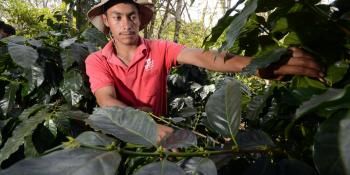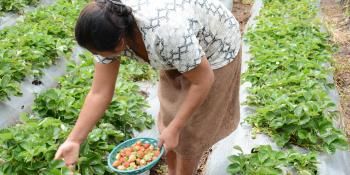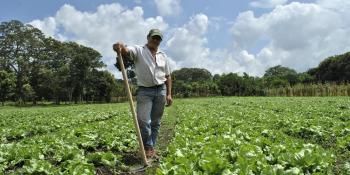Coping with climate change: Bangladeshi farmers boost food production with simple interventions

Techniques such as rice-field fish rings, vertical agriculture (vegetable towers) and climate-smart housing can increase farmers' resilience to climate change, while increasing food security and productivity.
When the first rains fall in Bangladesh, it signals a significant change in the game of cricket- the most popular sport in the country. In the dry season there is a good bounce of the ball and children can be seen playing in dusty parks. But come monsoon, the fields become water logged and muddy- but this doesn't necessarily stop children from continuing to play in the puddles. However water-logging and salt-water intrusion affects daily life and agriculture output.
Bangladesh has a mild ‘winter’ from November to March, and a hot humid summer from March to June. It has a warm monsoon season between June and October which supplies most of the country’s rainfall. Whilst the rains bring respite from the dry period, they also bring problems like flooding, water-logging and sea-water intrusion.
As a climate change researcher, I had learnt of Bangladesh being one of the most vulnerable regions in the world. Climate change and variability pose huge risks for food production and well-being in Bangladesh. Natural disasters such as floods, cyclones and tidal ‘bores’ occur in some form almost every year.
One cannot begin to fathom what vulnerability means until a visit to south west Bangladesh at the onset of the monsoon season. Bangladeshis have been adapting to the climate for centuries, but today farmers here are at the mercy of a more rapidly changing climate and their agricultural output is suffering .
People often talk of a time when six seasons used to bring with each of them a diversity of foods, fruits, fish. “The seasons are different now, we cannot predict when rains will come or if they will be good for us… sometimes they may harm us,”
says Emdad Hossain, project leader of the CCAFS Climate-Smart farm project.
View a video on the Climate-Smart Farm project
Climate change also presents opportunities which Worldfish and partners have been exploring with communities in south-west Bangladesh for the past three years.
WorldFish has been testing a range of innovations, together with farmer citizen scientists’, to help families boost food production in the face of variable climates. It also aims to deal with some of the more chronic problems caused by climate change such as salt-water intrusion.
“We need to suspend our agriculture, lift it up off the ground, we can grow vegetables in trees, along roofs and poles, we can hang pots from our houses,”
says Shibani Chakraborty, a CCAFS project officer who has lived and worked in the communities for three years.
Some examples include vegetable towers which are basically large plants (1.5m high by 1m wide) in pots supported by bamboo and polythene.
The plants are raised from the water-logged or saline soils where they thrive. A single tower costs about 300 taka (3.85 USD) to build, but can produce 100kgs of vegetables annually (brinjal, spinach, tomatoes) worth 3000 taka (38.49 USD) per cycle, of which there can be three or four a year.

A vegetable tower in Bangladesh. Photo: Worldfish
Another simple technology is rice-field fish rings. These are concrete rings placed in rice fields which act as a sanctuary for fish in the beginning and at the end of the monsoon season when the variability in the rainfall make it difficult for fish to survive in the rice fields as they frequently dry up. This gives the fish a fighting chance during the increasingly unpredictable monsoon season, which corresponds to the breeding season for many indigenous fish, as well as providing a diversified and thriving rice field fishery. More fish in the rice-field, means less pests and less fertilizer as fish aerate the soil.
These small fish, usually eaten whole, are highly nutritious and their regular consumption can make a real difference to child development.
“We need to make this information readily available to Bangladeshi farmers and to that end we’ve prepared some simple Technology Briefs which provide information on how to use these technologies and the benefits that can be expected”, says Doug Beare, a Senior Scientists and CCAFS Focal Point at WorldFish.
Farmers can also turn climatic changes and risks into opportunities, adapting their practices and technology to turn vulnerability into productivity, and CCAFS and Worldfish have been working with communities to do just that.
The technology briefs can be accessed here :
Fish ring microhabitats: Resilience in rice field fisheries
Climate-smart house: Housing that is cyclone resistant and food, energy and water efficient in Bangladesh
Vertical agriculture: Suspended horticulture in towers
Vertical agriculture: Homestead horticulture suspended in sacks
Alexander Kaminski is a WorldFish researcher based in Khulna, Bangladesh, working on the climate-smart farm project, funded by CCAFS.



